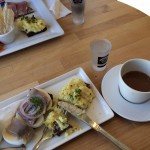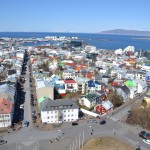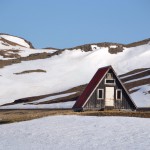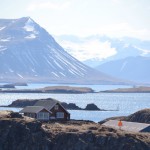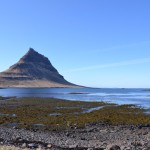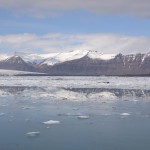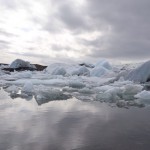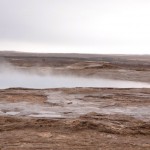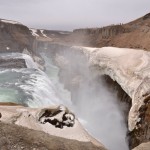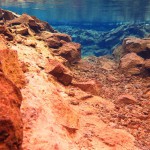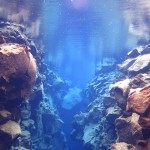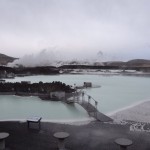The first stop of the eight-week round-the-world honeymoon was Iceland. It wasn’t really part of the round the world itinerary, since we had to return to Germany after a week for another day before going traveling onward on our round-the-world ticket. We departed to Iceland from Berlin on 10 May. Iceland, at this time of year, was still quite cold, with temperatures dropping to freezing overnight, but the days were already very long – at 10:30pm it would still be daylight.
We arrived in Reykjavik in the middle of the night, and went to bed right away. The first full day in Iceland we spent mostly relaxing from the stress of the previous week, which had been filled with last-minute wedding prep (mostly our hugely ambitious DIY plans), and so it was really nice to just stroll around Reykjavik without too much time pressure. We started the day with an Icelandic breakfast at Café Loki, which was located close to our guesthouse – rye bread and different types of fish: herring, mashed fish, dried fish and the Icelandic specialty: fermented shark. The waitress explained that most people take these shark pieces with Brennivin, an Icelandic spirit, to wash down the aftertaste, so that’s what we also did (for breakfast!). We also walked through Reykjavik’s city center, and looked at the humongous concrete Hallgrims church, the harbor, city hall, and enjoyed the sun between the colorful Nordic houses.
Starting Tuesday, we had a rental car. We first used it to drive up north to the Snæfellsnes peninsula. Outside of Reykjavik, Iceland quickly becomes very sparsely populated, but provides amazing sceneries between lava rock fields, glacier-covered peaks, and fjords. The peninsula itself was very beautiful, with picturesque small villages and fjords. On the way back to Reykjavik, we stopped at the Lagfellslaug baths in Mosfellsbær – our first of multiple bath visits. Iceland is of course equipped with lots of geothermal energy – a curse in the case of volcano eruptions such as Eyafjallajökull, but a blessing for the hot springs that power 90% of Icelands hot baths, in which you can sit in various “hot pots” – small pools of temperatures between 38 and 44 centigrade, which was amazingly relaxing in the cold Icelandic climate.
On Wednesday, we undertook an even further expedition: we drove along the southern section of the ring road, which circles all of Iceland, to Jökullsárlón, which meant more than four hours driving time each way, but it was definitely worth it. Jökullsárlón is a lagoon just off the coast, in which the Breiðamerkurjökull glacier dissolves into icebergs, which gradually melt and float down a short river to the sea. The lagoon is quite big, 18 square kilometers, and the scene is stunning: thousands of icebergs of various sizes, in colors from white to transparent blue, floating silently in the water. The drive there and back was also well worth it, through different types of Icelandic landscape and passing tiny towns, most of which had about two or three houses, sometimes a small church. Even though of course quite different in climate, the barren land and sparse population made me think of our long drive through Namibia. Back in Reykjavik, we went for a quick hot bath at Laugardalslaug, Reykjavik’s biggest bath, which we didn’t like as much as the one in Mosfellsbær, and then went for an excellent dinner at the small restaurant Resto in downtown Reykjavik.
For the next day, we had planned one of the highlights of the Iceland trip: diving the Silfra fissure. Since that is located in Þingvellir, which was the seat of Iceland’s first parliament in 930 AD, and our dive didn’t start until the afternoon, we also took some time in the morning for the Þingvellir and the two other “golden circle” sights which are nearby, namely the Gullfoss waterfall and Geysir, the hot spring which has lent its name to all geysers worldwide. Geysir itself erupts only very infrequently, hurling water up to 80 meters in the air, and while we were there, we didn’t get that lucky. Thankfully a somewhat smaller fountain, Strokkur, just a few meters next to Geysir, spits hot water up to 30 meters every few minutes. At around 1pm, we arrived at Þingvellir for our dive. The Silfra fissure is a unique dive site, and its main draw is not, as in many other places, the fauna. In fact, the opposite is true: we didn’t see a single fish. The reason is that the water in the fissure is Glacier water, which is seeping through lava rocks for years before it arrives in the crack. By then, it has been thoroughly filtered and purified, meaning amazing visibility when diving. It also, however, has almost no nutrients, which explains the lack of fish. Additionally, Silfra was created by the forces that push the Eurasian and North American tectonic plates apart – the fissure essentially separates the two plates, meaning in some narrow bits you can touch both plates at once. The dive itself was amazing. This being Iceland and glacier water at four centigrade, we needed to dive in dry suits with multiple layers of warming undergarments underneath (and carrying many kilos of additional equipment and weight, which made the walk to and from the water quite an ordeal). The crystal clear water and the serenity of floating weightlessly in between the rocks more than made up for it – this was a special experience which can’t be had anywhere else in the world.
Friday was our last day in Iceland. In the morning, we visited the museum “Reykjavik 871+/-2”, which recounts the history of the settlement of Iceland in the 9th century and is centered around the remains of a dwelling from that area that was dug up. On our way to the airport, we went for one last dip in a hot pool, namely the famous blue lagoon. The lagoon is filled with geothermally heated sea water, which is full of silica which is deposited on the rocks enclosing the lagoon, covering them with a solid white layer. The lagoon also sports steam baths and a sauna, and is clearly one of the main tourist drags – even though we were in Iceland outside the peak season, the lagoon was still packed with tourists when we arrived (in contrast to the other baths we had visited, which had mainly Icelandic guests). Thankfully, we had come quite late in the day, and shortly after our arrival many of the tourists that probably had come from Reykjavik on organized bus tours left, so that we had one last relaxing bath before flying back to Germany overnight.
- Icelandic Breakfast
- Hallgrimskjirka
- Reykjavik
- Solitary house on Snæfellsnes
- Snæfellsnes
- Snæfellsnes, view from Helgafell
- Kirkufell
- Jökullsárlón
- Jökullsárlón
- Steaming Geysir
- Gullfoss
- Silfra fissure
- Silfra fissure
- Diving in Silfra
- Blue Lagoon
Tags: Honeymoon, Iceland, Reykjavik, Round-the-World
